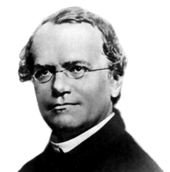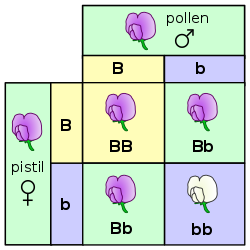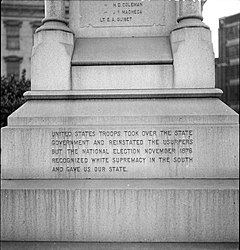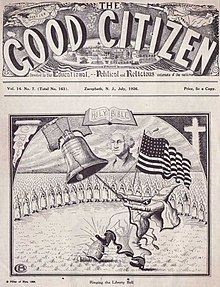Gregor Mendel, the Moravian Augustinian monk who founded the modern science of genetics
Mendelian inheritance is a type of biological inheritance that follows the laws originally proposed by Gregor Mendel
in 1865 and 1866 and re-discovered in 1900. These laws were initially
controversial. When Mendel's theories were integrated with the Boveri–Sutton chromosome theory of inheritance by Thomas Hunt Morgan in 1915, they became the core of classical genetics. Ronald Fisher combined these ideas with the theory of natural selection in his 1930 book The Genetical Theory of Natural Selection, putting evolution onto a mathematical footing and forming the basis for population genetics within the modern evolutionary synthesis.
History
The principles of Mendelian inheritance were named for and first derived by Gregor Johann Mendel, a nineteenth-century Moravian monk who formulated his ideas after conducting simple hybridisation experiments with pea plants (Pisum sativum) he had planted in the garden of his monastery.
Between 1856 and 1863, Mendel cultivated and tested some 5,000 pea
plants. From these experiments, he induced two generalizations which
later became known as Mendel's Principles of Heredity or Mendelian inheritance. He described these principles in a two-part paper, Versuche über Pflanzen-Hybriden (Experiments on Plant Hybridization), that he read to the Natural History Society of Brno on 8 February and 8 March 1865, and which was published in 1866.
Mendel's conclusions were largely ignored by the vast majority.
Although they were not completely unknown to biologists of the time,
they were not seen as generally applicable, even by Mendel himself, who
thought they only applied to certain categories of species or traits. A
major block to understanding their significance was the importance
attached by 19th-century biologists to the apparent blending of many inherited traits in the overall appearance of the progeny, now known to be due to multi-gene interactions, in contrast to the organ-specific binary characters studied by Mendel. In 1900, however, his work was "re-discovered" by three European scientists, Hugo de Vries, Carl Correns, and Erich von Tschermak.
The exact nature of the "re-discovery" has been debated: De Vries
published first on the subject, mentioning Mendel in a footnote, while
Correns pointed out Mendel's priority after having read De Vries' paper
and realizing that he himself did not have priority. De Vries may not
have acknowledged truthfully how much of his knowledge of the laws came
from his own work and how much came only after reading Mendel's paper.
Later scholars have accused Von Tschermak of not truly understanding the
results at all.
Regardless, the "re-discovery" made Mendelism an important but controversial theory. Its most vigorous promoter in Europe was William Bateson, who coined the terms "genetics" and "allele"
to describe many of its tenets. The model of heredity was contested by
other biologists because it implied that heredity was discontinuous, in
opposition to the apparently continuous variation observable for many
traits. Many biologists also dismissed the theory because they were not
sure it would apply to all species. However, later work by biologists
and statisticians such as Ronald Fisher
showed that if multiple Mendelian factors were involved in the
expression of an individual trait, they could produce the diverse
results observed, and thus showed that Mendelian genetics is compatible
with natural selection. Thomas Hunt Morgan and his assistants later integrated Mendel's theoretical model with the chromosome theory of inheritance, in which the chromosomes of cells were thought to hold the actual hereditary material, and created what is now known as classical genetics, a highly successful foundation which eventually cemented Mendel's place in history.
Mendel's findings allowed scientists such as Fisher and J.B.S. Haldane
to predict the expression of traits on the basis of mathematical
probabilities. An important aspect of Mendel's success can be traced to
his decision to start his crosses only with plants he demonstrated were true-breeding.
He only measured discrete (binary) characteristics, such as color,
shape, and position of the seeds, rather than quantitatively variable
characteristics. He expressed his results numerically and subjected them
to statistical analysis. His method of data analysis and his large sample size
gave credibility to his data. He had the foresight to follow several
successive generations (F2, F3) of pea plants and record their
variations. Finally, he performed "test crosses" (backcrossing
descendants of the initial hybridization to the initial true-breeding
lines) to reveal the presence and proportions of recessive characters.
Mendel's laws
A Punnett square for one of Mendel's pea plant experiments – self-fertilization of the F1 generation
Mendel discovered that, when he crossed purebred white flower and
purple flower pea plants (the parental or P generation), the result was
not a blend. Rather than being a mix of the two, the offspring (known as
the F1 generation) was purple-flowered. When Mendel self-fertilized the F1 generation pea plants, he obtained a purple flower to white flower ratio in the F2 generation of 3 to 1. The results of this cross are tabulated in the Punnett square to the right.
He then conceived the idea of heredity units, which he called
"factors". Mendel found that there are alternative forms of factors—now
called genes—that
account for variations in inherited characteristics. For example, the
gene for flower color in pea plants exists in two forms, one for purple
and the other for white. The alternative "forms" are now called alleles. For each biological trait,
an organism inherits two alleles, one from each parent. These alleles
may be the same or different. An organism that has two identical alleles
for a gene is said to be homozygous for that gene (and is called a homozygote). An organism that has two different alleles for a gene is said be heterozygous for that gene (and is called a heterozygote).
Mendel hypothesized that allele pairs separate randomly, or segregate, from each other during the production of gametes:
egg and sperm. Because allele pairs separate during gamete production, a
sperm or egg carries only one allele for each inherited trait. When
sperm and egg unite at fertilization, each contributes its allele, restoring the paired condition in the offspring. This is called the Law of Segregation.
Mendel also found that each pair of alleles segregates independently of
the other pairs of alleles during gamete formation. This is known as
the Law of Independent Assortment.
The genotype of an individual is made up of the many alleles it possesses. An individual's physical appearance, or phenotype,
is determined by its alleles as well as by its environment. The
presence of an allele does not mean that the trait will be expressed in
the individual that possesses it. If the two alleles of an inherited
pair differ (the heterozygous condition), then one determines the
organism’s appearance and is called the dominant allele; the other has no noticeable effect on the organism’s appearance and is called the recessive allele.
Thus, in the example above the dominant purple flower allele will hide
the phenotypic effects of the recessive white flower allele. This is
known as the Law of Dominance but it is not a transmission law:
it concerns the expression of the genotype. The upper case letters are
used to represent dominant alleles whereas the lowercase letters are
used to represent recessive alleles.
| Law | Definition |
|---|---|
| Law of segregation | During gamete formation, the alleles for each gene segregate from each other so that each gamete carries only one allele for each gene. |
| Law of independent assortment | Genes of different traits can segregate independently during the formation of gametes. |
| Law of dominance | Some alleles are dominant while others are recessive; an organism with at least one dominant allele will display the effect of the dominant allele. |
In the pea plant example above, the capital "B" represents the
dominant allele for purple flowers and lowercase "b" represents the
recessive allele for white flowers. Both parental plants were
true-breeding, and one parental variety had two alleles for purple
flowers (BB) while the other had two alleles for white flowers (bb). As a result of fertilization, the F1 hybrids each inherited one allele for purple flowers and one for white. All the F1 hybrids (Bb) had purple flowers, because the dominant B allele has its full effect in the heterozygote, while the recessive b allele has no effect on flower color. For the F2
plants, the ratio of plants with purple flowers to those with white
flowers (3:1) is called the phenotypic ratio. The genotypic ratio, as
seen in the Punnett square, is 1 BB : 2 Bb : 1 bb.
Law of Segregation of genes (the "First Law")
Figure 1 Dominant and recessive phenotypes.
(1) Parental generation.
(2) F1 generation.
(3) F2 generation. Dominant (red) and recessive (white) phenotype look alike in the F1 (first) generation and show a 3:1 ratio in the F2 (second) generation.
(1) Parental generation.
(2) F1 generation.
(3) F2 generation. Dominant (red) and recessive (white) phenotype look alike in the F1 (first) generation and show a 3:1 ratio in the F2 (second) generation.
The Law of Segregation states that every individual organism contains
two alleles for each trait, and that these alleles segregate (separate)
during meiosis such that each gamete contains only one of the alleles. An offspring thus receives a pair of alleles for a trait by inheriting homologous chromosomes from the parent organisms: one allele for each trait from each parent.
Molecular proof of this principle was subsequently found through observation of meiosis by two scientists independently, the German botanist Oscar Hertwig in 1876, and the Belgian zoologist Edouard Van Beneden
in 1883. Paternal and maternal chromosomes get separated in meiosis and
the alleles with the traits of a character are segregated into two
different gametes. Each parent contributes a single gamete, and thus a
single, randomly successful allele copy to their offspring and
fertilization.
Law of Independent Assortment (the "Second Law")
According
to independent assortment, 3 homologous pairs create 8 possible
combinations, all equally likely to be fertilized. The equation to
determine the number of possible combinations given the number of
homologous pairs = 2x (x = number of homologous pairs)
Figure 2 Dihybrid cross. The phenotypes of two independent traits show a 9:3:3:1 ratio in the F2 generation. In this example, coat color is indicated by B (brown, dominant) or b (white), while tail length is indicated by S (short, dominant) or s (long). When parents are homozygous for each trait (SSbb and ssBB), their children in the F1 generation are heterozygous at both loci and only show the dominant phenotypes (SsbB). If the children mate with each other, in the F2
generation all combinations of coat color and tail length occur: 9 are
brown/short (purple boxes), 3 are white/short (pink boxes), 3 are
brown/long (blue boxes) and 1 is white/long (green box).
The Law of Independent Assortment states that alleles for separate traits are passed independently of one another.
That is, the biological selection of an allele for one trait has
nothing to do with the selection of an allele for any other trait.
Mendel found support for this law in his dihybrid cross experiments
(Fig. 1). In his monohybrid crosses, an idealized 3:1 ratio between
dominant and recessive phenotypes resulted. In dihybrid crosses,
however, he found a 9:3:3:1 ratios (Fig. 2). This shows that each of the
two alleles is inherited independently from the other, with a 3:1
phenotypic ratio for each.
Independent assortment occurs in eukaryotic
organisms during meiotic metaphase I, and produces a gamete with a
mixture of the organism's chromosomes. The physical basis of the
independent assortment of chromosomes is the random orientation of each
bivalent chromosome along the metaphase plate with respect to the other
bivalent chromosomes. Along with crossing over, independent assortment increases genetic diversity by producing novel genetic combinations.
There are many violations of independent assortment due to genetic linkage.
Of the 46 chromosomes in a normal diploid human cell, half are maternally derived (from the mother's egg) and half are paternally derived (from the father's sperm). This occurs as sexual reproduction involves the fusion of two haploid gametes (the egg and sperm) to produce a new organism having the full complement of chromosomes. During gametogenesis—the
production of new gametes by an adult—the normal complement of 46
chromosomes needs to be halved to 23 to ensure that the resulting
haploid gamete can join with another gamete to produce a diploid
organism. An error in the number of chromosomes, such as those caused by
a diploid gamete joining with a haploid gamete, is termed aneuploidy.
In independent assortment, the chromosomes that result are
randomly sorted from all possible maternal and paternal chromosomes.
Because zygotes end up with a random mix instead of a pre-defined "set"
from either parent, chromosomes are therefore considered assorted
independently. As such, the zygote can end up with any combination of
paternal or maternal chromosomes. Any of the possible variants of a
zygote formed from maternal and paternal chromosomes will occur with
equal frequency. For human gametes, with 23 pairs of chromosomes, the
number of possibilities is 223 or 8,388,608 possible combinations.
The zygote will normally end up with 23 chromosomes pairs, but the
origin of any particular chromosome will be randomly selected from
paternal or maternal chromosomes. This contributes to the genetic
variability of progeny.
Law of Dominance (the "Third Law")
Mendel's
Law of Dominance states that recessive alleles will always be masked by
dominant alleles. Therefore, a cross between a homozygous dominant and a
homozygous recessive will always express the dominant phenotype, while
still having a heterozygous genotype.
The Law of Dominance can be explained easily with the help of a mono
hybrid cross experiment:-
In a cross between two organisms pure for any pair (or pairs) of
contrasting traits (characters), the character that appears in the F1
generation is called "dominant" and the one which is suppressed (not
expressed) is called "recessive."
Each character is controlled by a pair of dissimilar factors. Only one
of the characters expresses. The one which expresses in the F1
generation is called Dominant.
However, the law of dominance is not universally applicable.
Mendelian trait
A Mendelian trait is one that is controlled by a single locus
in an inheritance pattern. In such cases, a mutation in a single gene
can cause a disease that is inherited according to Mendel's laws.
Examples include sickle-cell anemia, Tay–Sachs disease, cystic fibrosis and xeroderma pigmentosa.
A disease controlled by a single gene contrasts with a multi-factorial
disease, like heart disease, which is affected by several loci (and the
environment) as well as those diseases inherited in a non-Mendelian fashion.
Non-Mendelian inheritance
In four o'clock plants, the alleles for red and white flowers show incomplete dominance. As seen in the F1 generation, heterozygous (wr) plants have "pink" flowers—a mix of "red" (rr) and "white" (ww) coloring. The F2 generation shows a 1:2:1 ratio of red:pink:white
Mendel explained inheritance in terms of discrete factors—genes—that
are passed along from generation to generation according to the rules of
probability. Mendel's laws are valid for all sexually reproducing
organisms, including garden peas and human beings. However, Mendel's
laws stop short of explaining some patterns of genetic inheritance. For
most sexually reproducing organisms, cases where Mendel's laws can
strictly account for the patterns of inheritance are relatively rare.
Often, the inheritance patterns are more complex.
The F1 offspring of Mendel's pea crosses always looked
like one of the two parental varieties. In this situation of "complete
dominance," the dominant allele had the same phenotypic effect whether
present in one or two copies. But for some characteristics, the F1 hybrids have an appearance in between the phenotypes of the two parental varieties. A cross between two four o'clock (Mirabilis jalapa) plants shows this common exception to Mendel's principles. Some alleles are neither dominant nor recessive. The F1 generation produced by a cross between red-flowered (RR) and white flowered (WW) Mirabilis jalapa
plants consists of pink-colored flowers. Neither allele is dominant in
this case. This third phenotype results from flowers of the heterzygote
having less red pigment than the red homozygotes. Cases in which one
allele is not completely dominant over another are called incomplete dominance. In incomplete dominance, the heterozygous phenotype lies somewhere between the two homozygous phenotypes.
A similar situation arises from codominance, in which the phenotypes produced by both alleles are clearly expressed. For example, in certain varieties of chicken,
the allele for black feathers is codominant with the allele for white
feathers. Heterozygous chickens have a color described as "erminette",
speckled with black and white feathers. Unlike the blending of red and
white colors in heterozygous four o'clocks, black and white colors
appear separately in chickens. Many human genes, including one for a
protein that controls cholesterol levels in the blood, show codominance,
too. People with the heterozygous form of this gene produce two
different forms of the protein, each with a different effect on
cholesterol levels.
In Mendelian inheritance, genes have only two alleles, such as a and A. In nature, such genes exist in several different forms and are therefore said to have multiple alleles.
A gene with more than two alleles is said to have multiple alleles. An
individual, of course, usually has only two copies of each gene, but
many different alleles are often found within a population. One of the
best-known examples is coat color in rabbits. A rabbit's coat color is
determined by a single gene that has at least four different alleles.
The four known alleles display a pattern of simple dominance that can
produce four coat colors. Many other genes have multiple alleles,
including the human genes for ABO blood type.
Furthermore, many traits are produced by the interaction of
several genes. Traits controlled by two or more genes are said to be polygenic traits. Polygenic
means "many genes." For example, at least three genes are involved in
making the reddish-brown pigment in the eyes of fruit flies. Polygenic
traits often show a wide range of phenotypes. The broad variety of skin
color in humans comes about partly because at least four different genes
probably control this trait.











